Sensing nanomaterials of wearable glucose sensors
2021-04-02GuangleiLiDanWen
Guanglei Li,Dan Wen*
State Key Laboratory of Solidification Processing, Center for Nano Energy Materials, School of Materials Science and Engineering, Northwestern Polytechnical University (NPU) and Shaanxi Joint Laboratory of Graphene, Xi’an 710072, China
ABSTRACT The metabolic disorder of glucose in human body will cause diseases such as diabetes and hyperglycemia.Hence the determination of glucose content is very important in clinic diagnosing.In recent years,researchers have proposed various non-invasive wearable sensors for rapid and real-time glucose monitoring from human body fluids.Unlike those reviews which discussed performances, detection environments or substrates of the wearable glucose sensor, this review focuses on the sensing nanomaterials since they are the key elements of most wearable glucose sensors.The sensing nanomaterials such as carbon,metals,and conductive polymers are summarized in detail.And also the structural characteristics of different sensing nanomaterials and the corresponding wearable glucose sensors are highlighted.Finally, we prospect the future development requirements of sensing nanomaterials for wearable glucose sensors.This review would give some insights to the further development of wearable glucose sensors and the modern medical treatment.
Keywords:Wearable sensors Glucose detection Sensing nanomaterials Noninvasive detection Flexibility
1.Introduction
Wearable sensors offer the possibility to monitor biochemical parameters of human body anytime and anywhere[1-4].In recent years, the combination of wearable biochemical sensors and information technologies has created new application fields such as intelligent sports and medical care,which greatly improved our standard and quality of living[5-9].Among various metabolites of human body measured by wearable biochemical sensors, glucose is the most common and important biomarker.Glucose not only provides energy for the metabolism of human body and the normal operation of various organs,but also is of great significance for the early detection and treatment of diseases such as diabetes and hyperglycemia [10-13].In addition, accurate, real-time and convenient measurement of human glucose content is an important research basis in clinical medicine, human physiology and other fields,which is crucial for the diagnosis and treatment of chronic diseases.Therefore, the wearable glucose sensors have been the most extensively studied wearable biochemical sensors.
The general approaches used in wearable glucose sensors are the optical [14-17] and the electrochemical methods [18-22].Among these approaches, electrochemical sensors are more suitable for wearable applications due to their advantages of fast response, high accuracy and simple operation.The earliest electrochemical-typed wearable glucose sensor is the GlucoWatch developed by the Cygnus company in 2001 [23].The glucose oxidase (GOD) modified working electrode was remarkably responsive to the glucose in the interstitial fluid.However, it caused inconvenience to users due to its plastic housing and poor long-term stability of working electrode.Nowadays,many kinds of wearable glucose sensors aiming to improve their performance have been proposed and fabricated by researchers [24-28].Particularly, with the continuous development of sensing materials and manufacturing technologies, the sensitivity, anti-interference ability and service life of wearable glucose sensors have been greatly enhanced,which are closer to the application requirements of glucose detection in human body.
For electrochemical wearable glucose sensors, sensing materials are one of the key components of the electrodes.Recently, nanostructured materials have attracted much attention and been widely used in a variety of the wearable glucose sensing schemes owing to their unique physical, electronic and chemical properties compared with those of bulk materials[26-29].Their high specific surface area can greatly increase the sensitivities of the sensors [28-30].The good biocompatibility generally maintains the working life of enzymatic wearable glucose sensors to enhance their long-term stability [31].The intrinsic stretchability of multi-dimensional nanomaterials endows the sensors an excellent flexibility, which is essential for wearable application[32].Furthermore,nanomaterials with porous structures provide excellent immobilization matrix of enzymes and meanwhile greatly improve the diffusion of the target and electrolyte, enhancing the catalysis of glucose [33].These advantages of sensing nanomaterials extend the performances as well as the design strategies of wearable glucose sensors.Lee proposed a wearable glucose sensor based on a typical two-dimensional (2D)nanomaterial, graphene modified with GOD[34].Precise measurements of glucose concentrations in sweat were realized to estimate the levels of glucose.In addition, the sensitivity of the proposed glucose sensor maintained well under mechanical deformations due to the high mechanical reliability and flexibility provided by graphene,demonstrating that the nanomaterials will provide new opportunities for the point-of-care of glucose.
Since the significant importance of the wearable glucose sensors, there are many literatures about this topic [35-39].However,most of them have been concentrated on their performances,detection environments or the substrates of electrodes[40-42].Here we will emphasize the recent work (2015-2020) about the sensing nanomaterials and how do they promote the development of wearable glucose sensors.Specifically speaking,Section 2 mainly introduces the carbon-based nanomaterials such as carbon nanotubes(CNTs)and graphene.Section 3 focuses on the metal-based nanomaterials such as metal nanoparticles, metal nanowires,metal nanosheets and metal aerogels.Sections 4 and 5 include the conductive polymers, Mxene and other composite nanomaterials.Some excellent wearable glucose sensors based on these nanomaterials will be highlighted.Finally, the future development trends of the sensing nanomaterials of wearable glucose sensors will be prospected.
2.Carbon-based nanomaterials
Carbonous materials have been used in many technical fields due to their good mechanical, thermal, electronic and biological properties [43-48].Carbon-based nanomaterials, in particular,generally have advantages of small size,large specific surface area and excellent biocompatability, wihch enable them to adsorb or bind different bioactive molecules such as drug molecules,proteins, antibodies, DNA and enzymes [45,46].Therefore, they are widely stuided and applied to prepare enzymatic sensing electrodes of wearable glucose sensors.In this section,the carbonbased nanomaterials such as CNTs, graphene used in wearable glucose sensors will be introduced in detail.
In recent years, CNTs, a typical kind of one-dimensional (1D)carbon nanomaterials, have attracted great attention and been applied to fabricate the sensing electrodes of wearable glucose sensors due to their excellent mechanical,electrical and chemical properties.The CNTs is considered to be a promising nanomaterial for loading and dispersing GOD on the electrode due to their large surface area and conductive network.They can increase the electron transfer between the enzyme and electrode through a direct electron transfer(DET)way,thus facilitating the catalysis of glucose and simplifying the sensing electrode fabrication[49-52].They can also be used to measure the hydrogen peroxide (H2O2),which is an intermediate product of enzymatic glucose sensor.Furthermore, the enzymatic electrodes composed of CNTs maintain good stability due to their excellent biocompatibility,which is also suitable to be coupled on the skin of human body.These advantages make CNTs an idea nanomaterial to construct wearable glucose sensors.For examples, Emaminejad et al.reported on CNTs to prepare a perspiration-based wearable glucose sensor (Fig.1) [50].The CNTs was employed as the immobilization matrix of GOD as well as the sensing materials of H2O2.Glucose adsorbed on the surface of the sensing electrode was transformed into gluconic acid and H2O2by GOD with the existence of oxygen.Then the concentration of glucose could be indirectly measured through the detection of H2O2.The prepared wearable glucose sensor could generate current signals proportional to the glucose concentration in a linearity range of 0-100 μmol/L with a sensitivity of 2.1 nA L μmol-1.Wearable applications were conducted on several subjects, demonstrating the excellent performances of proposed glucose sensor.
Graphene, which is a typical 2D layered nanomaterial, have attracted considerable attention as atomically thin channel materials.Compared with CNTs,graphene not only exhibits similar advantages such as large specific surface area, high conductivity,excellent biocompatibility and capability of DET[53],but also can effectively improve the stability and stretchability of the electrodes due to its high mechanical property and high flexibility, making graphene more suitable to be applied on wearable glucose monitoring [54-58].Prabhakaran prepared a graphene-based sensor for wearable monitoring glucose in human body fluids(Fig.2)[58].The wearable glucose sensor exhibited a low detection limit of 0.1 μmol/L, a linearity of 1 μmol/L -5 mmol/L, a rapid response time(less than 0.2 s)and a high selectivity.Noteworthy,the experimental results revealed that the proposed wearable glucose sensor features an excellent stretchability due to the high flexibility of the graphene.
In addition to the carbon nanomaterials mentioned above,there are some 3D structures, which are composed of carbon nanomaterial units(CNTs,graphene,carbon fibers and so on),becoming the research hotspots in recent years [59,60].The 3D structures composed of these nanomaterials have the advantages of controlled porosity, high surface area and conductivity, which can further improve the ability of loading enzyme and the surface functional groups,as well as increase the substrate diffusion to the network,making this kind of materials widely applied in wearable glucose sensors [33,61,62].A glucose sensor which could be used in a wearable contact lens was proposed by Ogata et al.(Fig.3)[62].Fluorine-doped carbon nanofibers was designed to 3D structures and applied to form the detecting channel of the sensor.The resulting glucose sensor showed a rapid response time(less than 8 s),low coefficient of variation for a series of sensors (<10%)within an analysis range of 50 μmol/L -5 mmol/L, and an excellent specificity.The glucose content in tears could be measured via the proposed sensor.
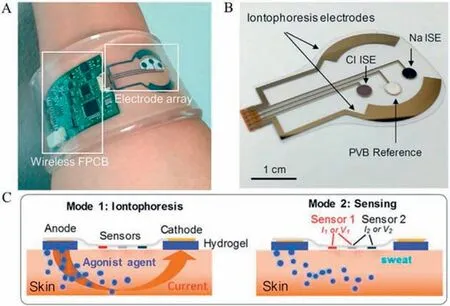
Fig.1.(A) Image of the autonomous sweat extraction and sensing platform.(B)Image of iontophoresis and sweat sensor electrodes.(C) Schematic illustrations of the iontophoresis and sensing modes.Reproduced with permission[50].Copyright 2017, National Academy of Sciences.
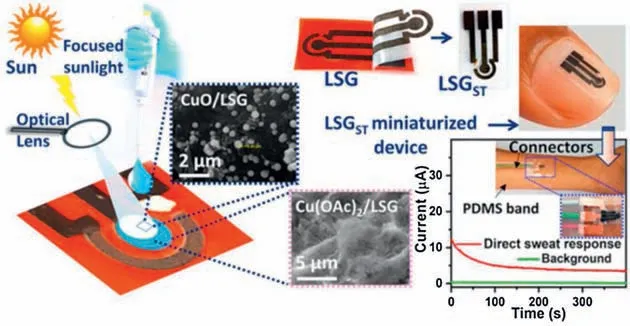
Fig.2.Schematic of the wearable glucose and the corresponding in vivo monitoring.Reproduced with permission [58].Copyright 2020, American Chemical Society.
Though carbon-based nanomaterials have been widely used in wearable glucose sensors due to their advantages such as good electrical conductivity, simple manufacturing process, and low cost,there still exists some limitations.The sensing electrodes are often modified with GOD since carbon-based nanomaterials generally cannot detect glucose directly.Besides the high cost of GOD, the poor stability of sensing electrodes is an important problem due to the inactivation of enzymes, limiting the widely application of enzymatic glucose sensors.
3.Metal-based nanomaterials
Metal-based nanomaterials have excellent electrical,mechanical properties as well as good catalytic performance to glucose[63,64], so they are considered as promising sensing materials of the wearable glucose sensors [65-69].Generally, they can be classified into noble and non-noble metal-based nanomaterials[70-74].The principle of glucose sensing based on non-noble metal-based nanomaterials mainly depends on the dehydrogenation of glucose by redox reaction of hydroxyl oxide, which is synthesized with metal oxides and hydroxyl in aqueous solution[75-80].However, the sensitivity of this kind of glucose sensor under neutral conditions is much lower than that under alkaline conditions.In contrast, noble metal-based nanomaterials have a higher catalytic effect on both glucose and hydrogen peroxide under neutral conditions, making them promising candidates for the manufacturing of wearable glucose sensors [81-85].Xuan proposed a wearable enzymatic glucose sensor based on goldplatinum alloy nanoparticles[82].The concentration of generated H2O2could be detected accurately due to the high catalytic effect of Au and Pt,thus realizing the glucose detection in sweat.It should be noticed that the reduced graphene oxide(rGO)was used to fix the sensing nanomaterials since the Au-Pt nanoparticles is in the form of dispersed particles.
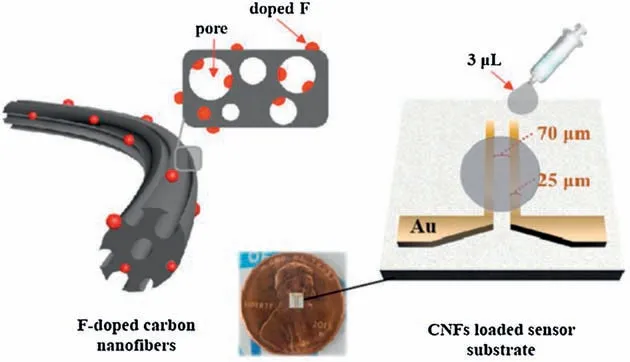
Fig.3.The structure of the glucose sensor and the corresponding performance.Reproduced with permission [62].Copyright 2018, American Chemical Society.
It is well known that the catalytic properties of a given nanomaterials depend on its morphology and composition.Thus,a lot of efforts have been devoted to synthesize various metal-based nanostructures such as nanowires, nanosheets and nanofilms.These nanomaterials can be designed to form 2D or 3D sensing electrodes, which can carry more enzymes and improve the catalytic efficiency [83-89].Zhai developed a wearable glucose sensor with mushroom-like gold nanowires (Fig.4) [83].The asprepared 3D standing nanowires offered high surface areas and good conductivity for electrochemical reactions.A limit of detection of 10 μmol/L (S/N = 3) and a sensitivity of 23.72 μA L mmol-1cm-2could be achieved by modifying the gold nanowires with GOD and Prussian blue (PB).In addition, a sensitivity of 4.55 μA L mmol-1cm-2toward glucose in the sweat was obtained even for 30% strain, which was due to the high flexibility of the gold nanowires.
Moreover, the non-enzymatic wearable glucose sensors based on metal-based nanomaterials attracted more interest and were studied by many researchers since most of them have high direct catalysis towards glucose[86-90].For example,Au nanosheet was(Fig.5A) applied to prepare a non-enzymatic wearable glucose sensor by Oh group [88].The Au nanosheet was formed into a network structure after filtering, which enhanced the sensitivity and the flexibility of the glucose sensor.The proposed glucose sensor could detect the glucose content in sweat with a sensitivity of 10.89 μA L mmol-1cm-2.In addition,the mechanical stability of the sensor was improved up to 30%stretching and air stability for 10 days.Similarly, Bae proposed a non-enzymatic glucose sensor with a 3D nanoporous gold (Fig.5B) [89].The nanoporous gold with large specific surface area ensured the sensor a high sensitivity of 253.4 μA L mmol-1cm-2.Furthermore, the mechanical durability maintained no degradation after 1000 cycles of stretching to 30% strain due to the high stretchability of the nanoporous gold, increasing the stability of the sensor.
In recent years,metallic aerogels,a new type of 3D metal-based nanomaterials, has been put forward by researchers, exhibiting excellent glucose bio-electrocatalysis and potential in wearable glucose sensors [91,92].Its porous structure and gel state are suitable to immobilize enzymes and maintain their activities,which is of great help to improve the service life of the glucose sensors[93].The palladium aerogels were assembled and applied to develop a glucose sensor after modified GOD by Wen.The glucose sensor realized qualitative and quantitative detection of glucose in 0.1 mol/L phosphate buffer solution (pH 7.4) [92],demonstrating its high potential to be applied in wearable applications.Additionally, the reasonable design of the multimetallic nanomaterials can comprehensively utilize the properties of two or more metal components compared with the monometallic system, so as to further improve the performances of wearable glucose sensors, which will also be a development direction of metal-based nanomaterials in the future.
4.Conductive polymer nanomaterials
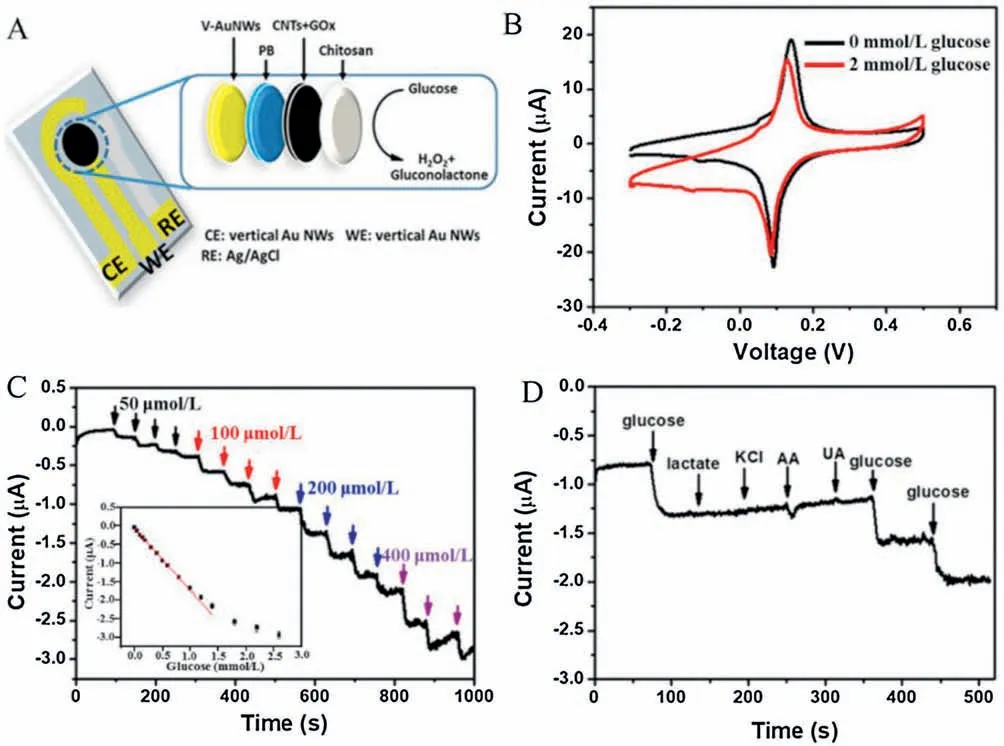
Fig.4.(A) Modification process of the Au nanowire-based wearable glucose biosensor.(B) CV curves of the fabricated stretchable biosensor before and after addition of glucose.(C) Chronoamperometric response of the fabricated stretchable biosensor upon successive addition of glucose at -0.1 V.(D) Selectivity study of the stretchable biosensor.Reproduced with permission [83].Copyright 2019, American Chemical Society.
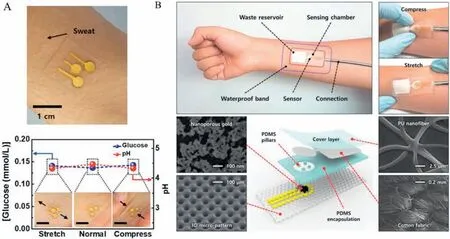
Fig.5.(A)The wearable glucose sensor based on Au nanosheets.Reproduced with permission[88].Copyright 2018,American Chemical Society.(B)Schematic of wearable glucose sensor based on nanoporous gold.Reproduced with permission [89].Copyright 2019, American Chemical Society.
Since the wearable glucose sensors need to be coupled on the surface of human skin to detect the target, the flexibility and the reliability of the sensors are the necessary in order to alleviating the motion-induced signal interference.Although carbon and metal-based nanomaterials have many advantages, they are not flexible enough.In order to improve their flexibility, researchers have excavated and developed conductive polymer nanomaterials(such as polypyrrole, polyaniline, polythiophene) to fabricate sensing electrodes [94-98].Besides excellent flexibility, the conductive polymer nanomaterials own the following outstanding properties: (a) They generally have a 3D structure, which can provide a larger specific surface area and thus improve the capability of loading enzymes as well as the electrochemical responses of the sensors.(b) The modification of conducting polymer nanomaterials on the sensing electrode is relatively simple since it has no special requirements for the flatness of the electrode surface.After compounded with organic and metalbased nanomaterials, the stability and conductivity of the polymer nanomaterials would be further enhanced [97,99].The modified electrodes can be stored for a long time without denaturation, which is of great significance for the practical application of wearable glucose sensors.A wearable glucose sensor based on poly(3,4-ethylenedioxythiophene)-poly(styrene sulfonate) (PEDOT-PSS) was designed by Zahed recently (Fig.6) [94].The PEDOT-PSS was used to improve the mechanically robust and deliver uniform electrically conductive of the electrode.The fabricated biosensor exhibited an excellent current response to glucose with a wide linear range of 10 μmol/L-9.2 mmol/L,a high sensitivity of 247.3 μA L mmol-1cm-2,and a low detection limit of 3 μmol/L.In addition,the electrode of the sensor could bend up to approximately 150°(Fig.6B),which is benefit from the flexibility of PEDOT-PSS.Moreover, conductive polymer nanomaterials also have the advantage of low cost, making them a kind of popular nanomaterials in wearable sensing devices,which are very suitable for widely application and commercialization [95].

Fig.6.(A)Schematic illustration of the wearable glucose sensor based on poly(3,4-ethylene dioxythiophene)-poly(styrene sulfonate).(B)Current response with a range of glucose concentrations from 3 μmol/L to 9.2 mmol/L.(C) Optical images for bending conditions of the fabricated sensing electrode.Reproduced with permission [94].Copyright 2020, Elsevier.
5.The other sensing nanomaterials
In addition to the above sensing nanomaterials,there are also some new nanomaterials with excellent electrical conductivity,large specific surface area and good biocompatibility emerging in the field of wearable glucose sensors.For example, Mxene is a kind of 2D inorganic compound composed of transition metal carbide, nitride or carbonitride with the thickness of several atomic layers [100-102].Due to the surface hydroxyl or end oxygen, Mxene nanomaterials have good electrical conductivity of the transition metal carbides, which is very suitable to be applied as the sensing nanomaterials of glucose sensors[103,104].For instance,Lei firstly put forward a wearable glucose sensor with 2D Mxene (Ti3C2Tx)(Fig.7)[103].The electrochemical performance was greatly improved due to the excellent conductivity and electrochemical activity of Ti3C2Tx.A typical electrochemical sensitivity of 35.3 μA L mmol-1cm-2for glucose in the artificial sweat was achieved.The detection limit of the glucose sensor was 0.33 × 10-6mol/L (S/N = 3).During in vitro sweat monitoring, the glucose sensor demonstrated a high selectivity and good repeatability.
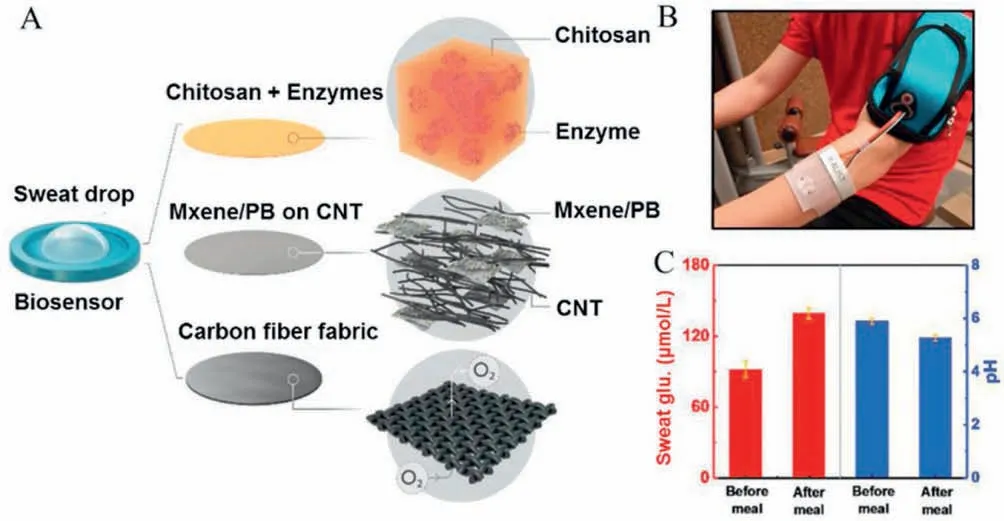
Fig.7.(A) Schematic illustration of the wearable glucose sensor based on Mxene.(B) The wearable sweat-monitoring patch was connected to a portable electrochemical analyzer on the skin.(C) Comparison of glucose and pH levels before and after meals with three different glucose and pH sensors.Reproduced with permission [103].Copyright 2019, John Wiley and Sons.

Fig.8.Schematic of the wearable glucose and the corresponding in vivo monitoring.Reproduced with permission [105].Copyright 2019, American Chemical Society.
Graphene/polymer nanocomposites also show amazing potential in wearable glucose sensors.These composites modified electrodes have both the excellent conductivity of graphene and the advantages of the polymer nanomaterials,which can enhance the biocompatibility, flexibility and sensitivity of biochemical sensors [105-108].Toi et al.prepared a wearable glucose sensor based on rGO/polyurethane (PU)composite fiber modified with oxygen-containing functional groups (Fig.8) [105].The wearable glucose sensor exhibited high responsivity to glucose with a sensitivity of 140 μA L mmol-1cm-2, a low detection limit of 500 nmol/L and high selectivity against interferences.Moreover, the proposed wearable glucose sensor could be stretched up to 30%and featured a high mechanical durability under repetitive cycles of deformation owing to the high strechability of rGO/PU fiber.
6.Conclusion and outlook
Wearable glucose sensors play crucial roles for continuous glucose monitoring.The sensing materials, which are the key components of most wearable glucose sensors, to a large extent decide the performances and potential practical application of such sensors.Recently, the emerging sensing nanomaterials are studied and applied to design the wearable glucose sensors due to the characteristics such as high specific surface area,high porosity and good accessibility, providing new approaches for wearable glucose measurement.In this review, different types of nanomaterials for sensing electrode of wearable glucose sensors are summarized.
Overall, owing to the advantages of good electrical conductivity, excellent biocompatibility and low cost, carbon-based nanomaterials (CNTs, graphene, etc.) have been widely used in the fabrication of sensing electrodes for wearable glucose sensors.However,GOD generally needs to be modified on the sensing electrodes since the carbon-based nanomaterials cannot directly catalyze the glucose.Therefore, the decrease of service life of the wearable glucose sensor caused by the inactivation of enzyme is the dominant problem which affects its widespread application and commercialization.The metalbased nanomaterials, especially noble metal-based ones with large specific surface area and high electrocatalytic effects, can directly detect glucose without GOD,featuring better stability.But the cost is obvious high.The application of conductive polymer nanomaterials in wearable glucose sensors is aimed at improving the flexibility of the sensor in order to ensure the good performances of the glucose sensor after coupled with the human body.The output characteristics of wearable glucose sensors will not be changed under various movements of the human body.Therefore, the catalytic characteristic was not as good as that of metal-based nanomaterials.Wearable glucose sensors can be made of different nanomaterials according to the requirements of practical applications.
Nowadays, more new nanomaterials will be developed and applied to prepare sensing electrodes of the wearable glucose sensors.In general,the sensing nanomaterials of wearable glucose sensor in the future may have the following development trends.Firstly,the sensing nanomaterials with porous structure,excellent electrical conductivity and catalytic ability will be widely used in both enzymatic sensors and non-enzymatic sensors so as to significantly improve the sensitivity of the sensors.Secondly, the sensing nanomaterials should have better mechanical properties in order to further enhance the reliability and flexibility of the sensors during daily activities.Thirdly, the nanomaterials with specific recognition of glucose may attract more attention to enhance the selectivity of the wearable glucose sensors,since there are various interferences (such as lactate, Na+, K+) in body fluids.Finally,the nanomaterials should exhibit excellent biocompatibility to ensure the long-term wearable application of glucose sensors for the human body.In addition, the fabrication processes of sensing nanomaterials should be simpler and cheaper,which will reduce the cost of sensors.Therefore,although the development of wearable glucose sensors is very rapid in the past decade,further efforts is still needed to realize their real application in the fields of medical care, fitness and military.
Declaration of competing interest
The authors declare that they have no known competing financial interests or personal relationships that could have appeared to influence the work reported in this paper.
Acknowledgments
This work is supported by the National Natural Science Foundation of China (Nos.21804108, 61901389), the Natural Science Foundation of Shaanxi(No.2019JM-239),the Fundamental Research Funds for the Central Universities (Nos.3102019PY008,3102019JC005), the Research Fund of the State Key Laboratory of Solidification Processing (NPU, No.2020-BJ-02) and the 1000 Youth Talent Program of China.
杂志排行
Chinese Chemical Letters的其它文章
- Diverse synthesis of the C ring fragment of bryostatins via Zn/Cu-promoted conjugate addition of α-hydroxy iodide with enone
- Directly conversion the biomass-waste to Si/C composite anode materials for advanced lithium ion batteries
- Mechanism and selectivity of copper-catalyzed borocyanation of 1-aryl-1,3-butadienes: A computational study
- Recent advances in the improvement of g-C3N4 based photocatalytic materials
- In-situ electro-deposition synthesis of MnOx-NiCo2O4 monolithic catalyst with rich phase interfaces
- Aconapelsulfonines A and B, seco C20-diterpenoid alkaloids deriving via Criegee rearrangements of napelline skeleton from Aconitum carmichaelii
